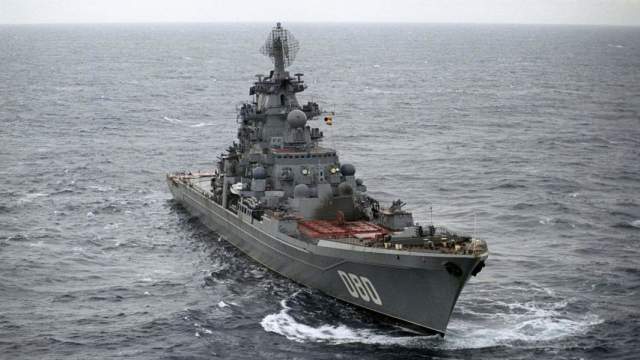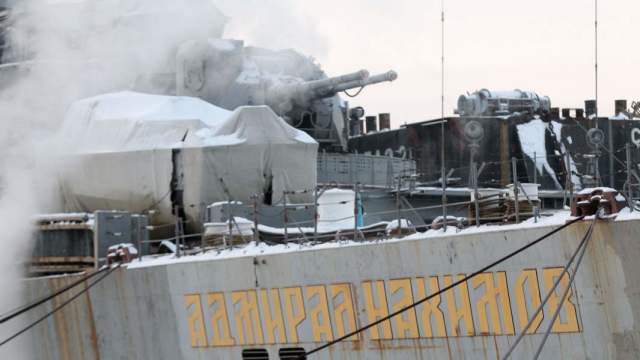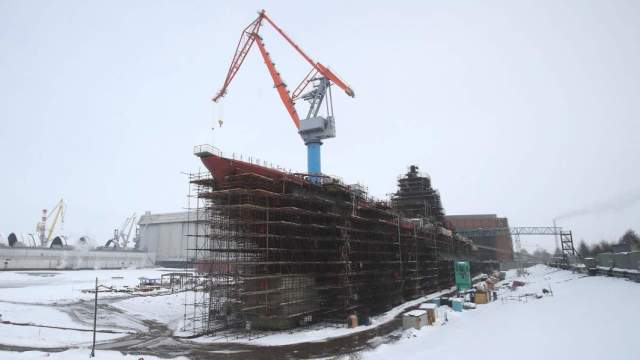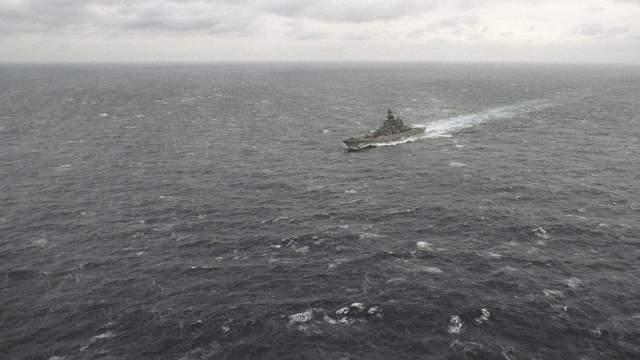What opportunities will the most powerful Navy ship acquire after a long modernizationThe Ministry of Defense agreed on the schedule of work and the preparatory stage of testing for Admiral Nakhimov.
The project 11442M cruiser is one of the largest warships in the world. Built in the late 1980s, it served in the Northern Fleet. But in the late 1990s it was sent for repairs. Work on the return of the Nakhimov to the Russian Navy started in 2013. After modernization, the updated cruiser will become the most powerful ship of the Russian fleet and a real flagship. Izvestia dealt with what kind of cruiser it is and what opportunities it will receive after the update.
Atomic "Eagles"
As sources in the military department told Izvestia, the schedule of work on board the Admiral Nakhimov nuclear missile cruiser, as well as the preparatory stage of its tests, have already been agreed. After their completion, the state commission will decide whether the cruiser is ready for testing and going to sea
The history of heavy nuclear missile cruisers of project 1144 goes back to the distant 1960s. It was then that research began in the USSR on the concept of a large surface anti-submarine ship with a nuclear power plant. The main task for him at that time was considered to be the destruction of enemy nuclear submarines in the areas of their combat duty. As a result of the research, the design bureaus developed a technical task for the development of the project of a large anti-submarine ship "Orlan" with a nuclear power plant, having a displacement of 8 thousand tons. The development of the project was entrusted to the Leningrad Northern Design Bureau. The project was considered a high priority from the very beginning and was directly supervised by the Commander-in-Chief of the USSR Navy S.G. Gorshkov.

Admiral Nakhimov Heavy Nuclear missile Cruiser
Image source: Photo: RIA Novosti/Oleg Lastochkin
Already in the design process, the ship was proposed to be additionally equipped with echeloned air defense systems, and later with an anti—ship missile system focused on use against an aircraft carrier group of a likely enemy. Due to the increase in displacement and the universalization of the possible purpose of the ship, it was decided to classify it as a "heavy nuclear missile cruiser" and build a series of several units.
The laying of the project's lead ship took place at the Baltic Shipyard in Leningrad on March 26, 1974. The first heavy nuclear-powered missile cruiser, named Kirov, was transferred to the fleet in 1980.
Following the lead Kirov, two more cruisers were built according to the redesigned project 11442: Frunze and Kalinin, which the USSR fleet received in 1984 and 1988, respectively. The third — "Yuri Andropov" — was launched in 1989. In 1991, when the Soviet Union ceased to exist, it was still unfinished. In new Russia, it was completed and put into operation already under the name "Peter the Great". In 1998, after testing, the new flagship of the Russian fleet was accepted into its composition.
Repair issues
Other Soviet-built heavy missile cruisers were also renamed in the early 1990s. The head "Kirov" became "Admiral Ushakov", "Frunze" was called "Admiral Lazarev", and "Kalinin" — "Admiral Nakhimov". The fate of all of them turned out to be dramatic — such large ships required expensive maintenance and repairs, which could not be provided in the 1990s. As a result, by the end of the 1990s of the last century, all three nuclear giants froze at the berths.
Only in 2008, on the heavy nuclear missile cruiser Admiral Nakhimov, the Sevmash production association began work on preparing for repairs. At the same time, a large modernization project was being developed for the ship, which received the designation 11442M. In June 2013, a contract worth 50 billion rubles was signed between the Ministry of Defense and Sevmash Software with a deadline for the delivery of the ship to the fleet in 2018. On October 24, 2014, the cruiser was brought into the Sevmash filling pool, after which work began on the modernization of the ship, which continues to the present.

Admiral Nakhimov Nuclear Missile Cruiser
Image source: Photo: RIA Novosti/Alexey Kudenko
The volumes for the replacement of old equipment, repair of wiring and power plant turned out to be higher than planned and knocked the repair out of the schedules. The budget of the initial project was also exceeded several times. In many ways, the fact that Sevmash had to rebuild the entire cooperation of hundreds of enterprises from scratch, look for replacements for components and nodes of those plants that remained outside Russia in the CIS countries. But as a result, today Sevmash is going to the final installation work. The installation of weapons systems is underway, work with equipment is being completed.
The ship is being prepared to leave first for mooring, and then for sea trials. According to the plans announced by the company, this should happen before the end of 2023. Subsequent tests of a ship of this class can take quite a long time — from six months to one and a half or even two years.
A new start
How will the updated Nakhimov change? Here it is worth mentioning the initial characteristics of a heavy nuclear cruiser. The total displacement of the ship is almost 26,400 tons . The length of the case is 250 m, width — 28.5 m. The full speed is 31 knots, i.e. 57 km / h — these are impressive indicators for a structure weighing more than 20 thousand tons. The ship's armament and all electronics, radars and communications equipment, power plant and combat control systems will be completely updated.
The main striking force of the updated cruiser will be long-range cruise missiles. Instead of 20 heavy supersonic Granit missiles, the ship will be equipped with several — according to some estimates, up to ten universal launchers of the Kalibr-NK complex with Kalibr and Onyx missiles. If the estimates are correct, then this is 80 missiles — a record number for our surface fleet. The same installations can use hypersonic "Zircons". It should be recalled that this weapon in the version for surface ships in 2022 has already been adopted by the fleet. "Zircons" were placed and tested on the newest frigate "Admiral of the Fleet of the Soviet Union Gorshkov" project 22350.

Heavy nuclear missile cruiser Admiral Nakhimov at the Sevmashpredpritie plant
Image source: Photo: IZVESTIA/Alexander Kazakov
The defense of the cruiser will be carried out by the Fort-M and Pantsir-M zonal air defense systems. Today it is one of the most advanced air and missile defense systems for fleet ships. Anti-submarine defense will be provided by the Response missile system and the Package multipurpose torpedo system. Torpedoes of the latter can hit both ships and submarines, as well as enemy torpedoes attacking the cruiser.
With the arrival of the Nakhimov, the Russian fleet will receive the world's most armed surface ship equipped with powerful defense systems and unique hypersonic and supersonic strike missiles. There is not a single combat task that such a combat unit could not solve, especially with support. The effectiveness of any fleet is precisely in the group actions of squadrons of ships supported by aircraft and submarines. Therefore, Admiral Nakhimov should be accompanied by the ocean frigates of Project 22350 currently under construction and multifunctional nuclear attack boats of the Yasen-M type. It is this combination that will give the upgraded cruiser universal capabilities.
Dmitry Kornev
Alexey Ramm

